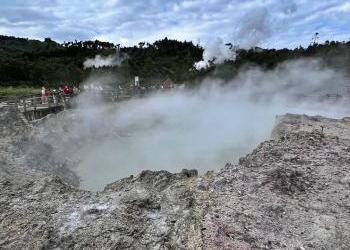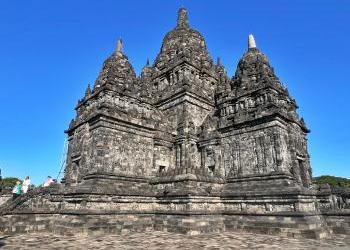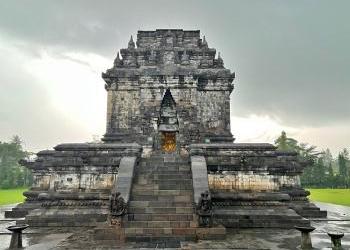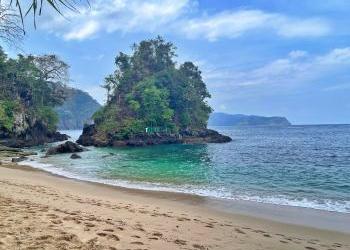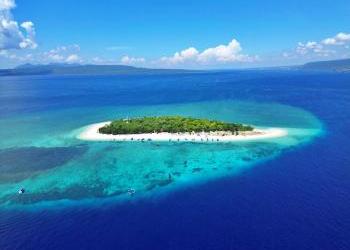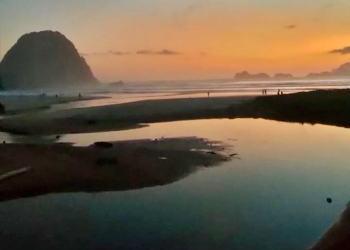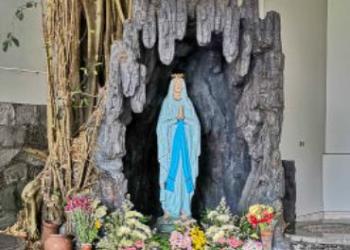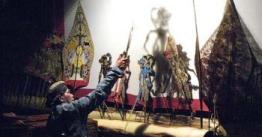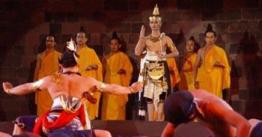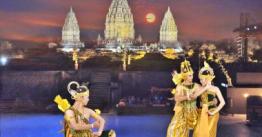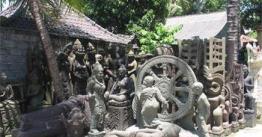Sikidang Crater lies in the heart of the mystical Dieng Plateau, Sikidang Crater is one of the most fascinating and easily accessible natural phenomena in the region. Unlike other volcanic craters, which tend to be static, Sikidang Crater is famous for its active sulfur gas vents that can move around the crater's vast area. This is what gave it the name "Sikidang," which in Javanese means "deer" or "deer," reflecting its habit of jumping or moving around.
You are here
Indonesia Tourism
-
-
Just a small pile of stones from the magnificent Prambanan Temple complex in Central Java, lies Sewu Temple, a Buddhist temple of immense historical and architectural significance. Although its name means "A Thousand Temples," Sewu Temple actually consists of a main temple surrounded by 249 smaller perwara (subsidiary) temples, creating a majestic structure resembling a mandala.
-
Hidden amidst lush greenery in Magelang, Central Java, Mendut Temple stands as a serene and often overlooked masterpiece of ancient Javanese art. While many visitors flock to the monumental Borobudur Temple, just three kilometers away, Mendut Temple offers a more intimate and tranquil experience, providing a fascinating glimpse into the rich history of the Syailendra Dynasty.
-
Green Bay, a hidden behind steep cliffs and dense forests on the eastern tip of Java, Teluk Ijo is a small bay in Banyuwangi that offers extraordinary natural beauty. Nicknamed so because its seawater radiates a captivating emerald green, this bay is a paradise for explorers seeking tranquility and pristine scenery.
The visitors must undertake a fairly challenging journey. Typically, the journey begins at Rajegwesi Beach, followed by a 15-20 minute ride on a small motorboat, or for the more adventurous, a trek through the forest for about an hour. This sense of adventure is an integral part of Teluk Ijo's charm.
-
Tabuhan Island lies in the Bali Strait, not far from the coast of Banyuwangi, Tabuhan Island is a small, uninhabited island offering extraordinary natural beauty. Dubbed Banyuwangi's "hidden gem," it's the perfect destination for those seeking tranquility, crystal clear waters, and captivating underwater beauty.
-
Pulau Merah Beach lies in Pesanggaran District, Banyuwangi Regency, Pulau Merah Beach is one of the most famous and stunning tourist destinations on the southern coast of East Java. The beach takes its name from a small, 200-meter-high hill located not far from the shoreline. At sunset or sunrise, the hill radiates a dazzling reddish hue, as if the hill itself were red.
-
Borobudur Temple is one of the wonders of the world, recognized by UNESCO, and it located in the beautiful Menoreh Hills. Built in the early 8th century by the Syailendra Dynasty, this Buddhist monument lay buried and forgotten for over 1,000 years before being rediscovered by Sir Thomas Stanford Raffles in 1814.
-
Barede hill is located west part of Borobudur Temple in Magelang, Central Java, Barede Hill is a hidden destination offering spectacular sunrise views with the iconic silhouette of Borobudur as a backdrop. This hill is an attractive alternative for photography enthusiasts and nature lovers who want to witness Borobudur's majesty from a different perspective.
-
Situ Patenggang is a stunning natural lake, known not only for its serene panoramic beauty but also for the love legend closely associated with it. Surrounded by expansive green tea plantations and mist-shrouded hills, the lake is a favorite destination for those seeking serenity and romance.
-
Saung Angklung Udjo is located in Bandung, West Java, Saung Angklung Udjo (SAU) is more than just an entertainment venue; it is a center for the preservation and development of Sundanese cultural arts, particularly the angklung. Founded in 1966 by the late Udjo Ngalagena and his wife, Uum Sumiati, SAU has become an icon preserving the angklung heritage not only for Indonesia but also for the world.
-
Gong Cave is widely known as one of the most beautiful caves in Southeast Asia, often referred to as Pacitan's "hidden gem." The name "Gong" itself comes from the gong-like humming sound said to be emitted from within the cave when water droplets hit certain stalactites or stalagmites.
-
Kalibaru plantation tour is located at the eastern tip of Java Island, between the foothills of the mountains and the coast, Kalibaru in Banyuwangi offers more than just beautiful scenery. This area is a paradise for botany lovers and those looking to delve deeper into Indonesia's agricultural riches through a unique and educational spice plantation tour. Kalibaru is known as one of East Java's plantation centers, where a variety of tropical commodities thrive thanks to its ideal climate and soil.
-
Watu Karung Beach is a Hidden Surfer's Paradise in Pacitan. It located on the southern coast of Pacitan Regency, East Java, Watu Karung Beach is a hidden gem that has attracted surfers and nature lovers from around the world. Known for its challenging waves and pristine natural beauty, Watu Karung offers a beach experience unlike any other.
-
Taman Kili-Kili Turtle Beach Conservation is a beacon of hope on Java's South Coast. The hidden gem behind green hills and the rolling waves of the Indian Ocean, Kili-Kili Beach in Trenggalek, East Java, not only offers stunning natural beauty but also serves as a beacon of hope for sea turtle conservation. This area has developed into a key sea turtle conservation center on Java's south coast, playing a crucial role in maintaining the population of this ancient marine animal.
-
Sendang Sriningsih Mary Cave: Silence and Peace in Yogyakarta
Located on the cool hillsides in the Prambanan area, Sleman, Yogyakarta, Goa Maria Sendang Sriningsih is a religious tourism destination that offers tranquility and peace for pilgrims. This place is not just an ordinary cave, but a pilgrimage complex that combines natural beauty with spiritual solemnity. -
The full name of the Mojonsongo Mary Cave is the Cave of the Virgin Mary Regina Mojosongo. It is a pilgrimage site for Catholics located in the village of Mojosongo, Jebres, Solo. This Mary Cave is located in the Parish of the Virgin Mary Regina, Purbowardayan under the direct jurisdiction of the Archdiocese of Semarang, Central Java.
Pages
Copyright © 2025,

